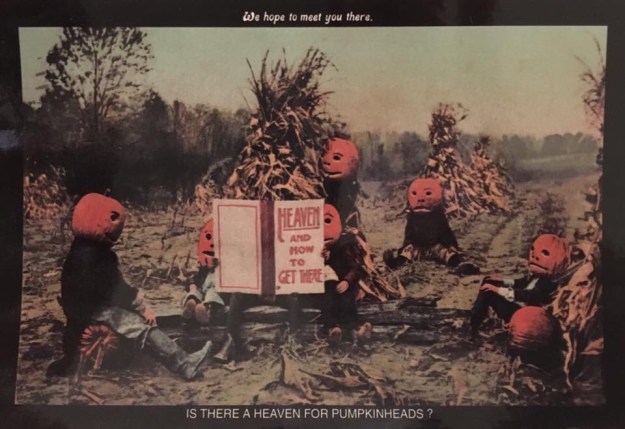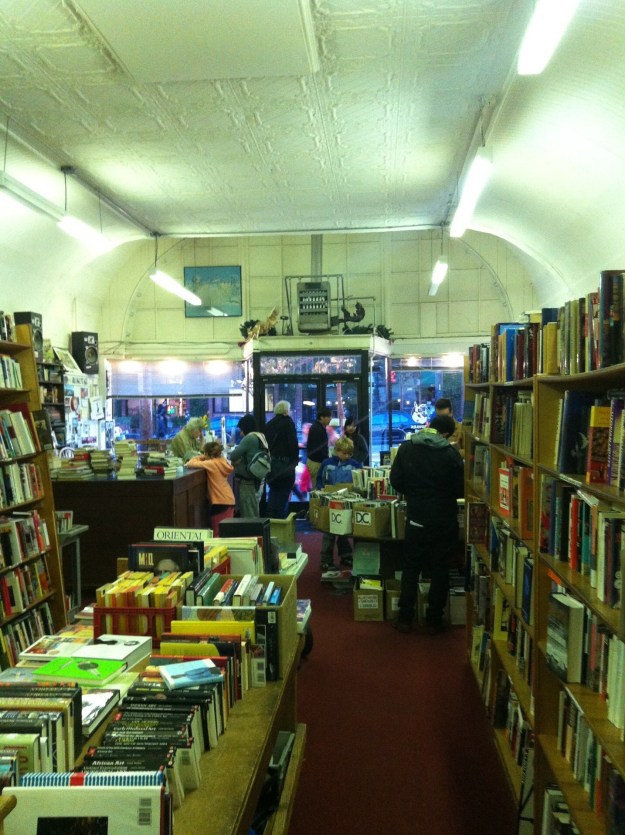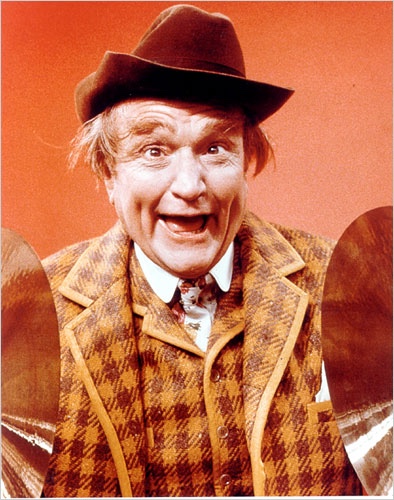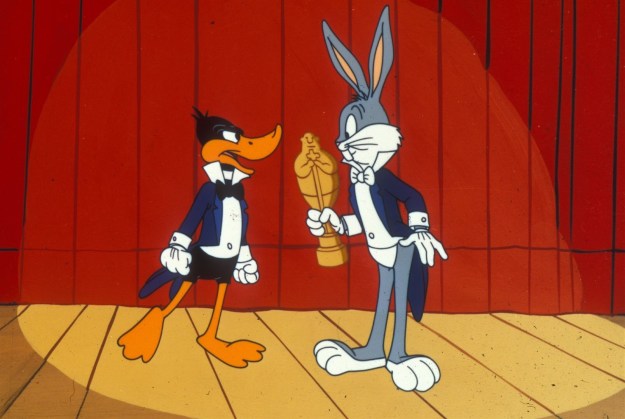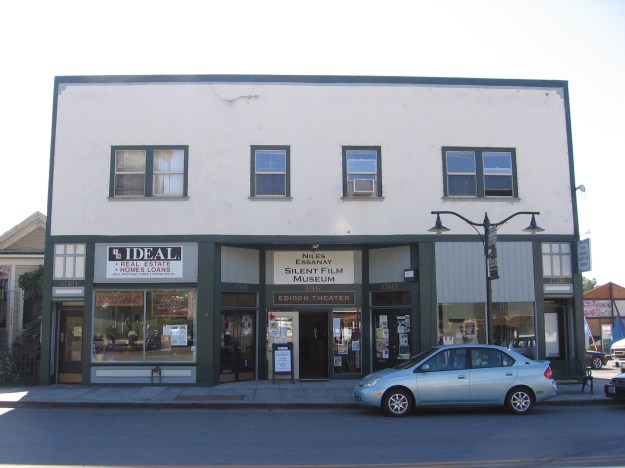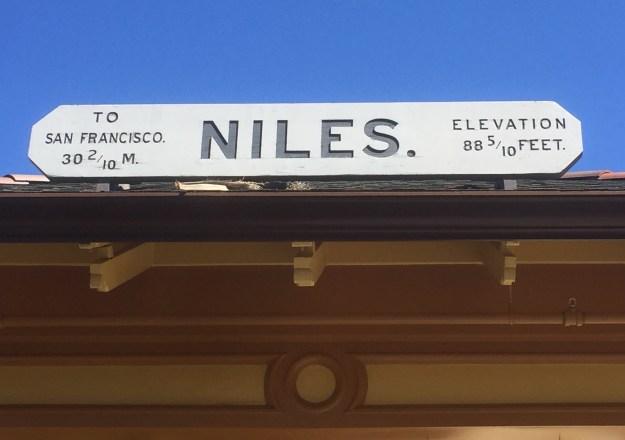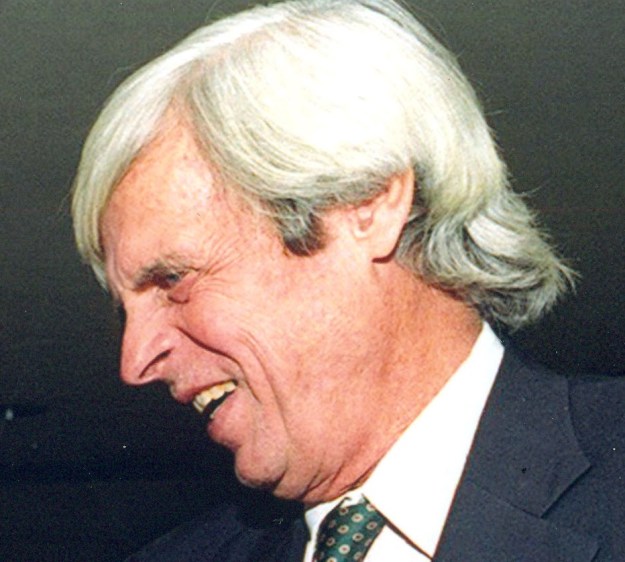Pumpkinalia:
A Pumpkin Prose Rhapsody
He walks on long vine-like legs, clad in pinstripes, hatless in holiday garb, his orange countenance, his serrated smile (a pumpkin for a head) relates him stylistically to the scarecrow, with rags and ribbon blowing in the autumn air.
Or he rides a midnight steed and might hurl his melon in a grinning lapse of judgement- grinning, spinning in a fiery arc of orange and pumpkin seeds, with a hyena laugh that issues from who knows where, for Jack’s lantern has no larynx. He is hollow on Halloween. His is a silly sacrifice, a trick on the gods, as if to say “we’ve something luminous, precious afire for thee, come see, come see…”
Pumpkins of various sizes, by twos and threes on doorsteps, are gaping and leering like Three Stooges, smirking and scowling like Little Rascals. The dramatis personae of Pumkinalia lacks depth, of not variety and novelty.
Yes, bewitched and bewildered, he sits on a table top, resting on newspaper, amid spattered guts, as with nip and tuck, and the practiced art of carving, he arrives at his present state. Hacked from the spinning vine, trucked to the city, then carved by your ever-loving mom, voila’: Mr Jack O’Lantern, at your service.
I’m pondering pumpkinology, wondering what exactly animates the fad for faces on this inert and wonderful plant form. What gives it legs? How does it come to be that a vegetable goes from simple and seedy to sprite? What pumpkinetic forces, what pumpkinomics are involved?
Walking with an old friend (and near to the season) I brought up the subject of Halloween and asked about the old days in Takoma, where he’s from. I tried to be subtle. “About pumpkins…they don’t pop out of the ground orange, do they?”
I was almost sorry I asked. He looked positively shocked at my ignorance. And then, instead of waxing favorably on pumpkin lore, he changed the subject to the harvest time he remembered, of cucumbers and squashes, and pickles and preserves, all stocked in the old root cellar in the country home in which he grew up.
I didn’t realize that he was outlining Jack O’Lantern’s family tree- or vine, more properly.
The botanical genus is cucurbitaceae. It includes the vines of squashes and cucumbers, watermelon, edible gourds; these are the pumpkin kith and kin.
The thought of the old root cellar reminded me of the basement of my grandmother’s house, with its coal chute, and dusty photos in giant frames of our dour-looking nineteenth- century relatives. The place was probably haunted, the coal chute a relic of an earlier era. Spooky.
But a family get-together of Pumpkin’s root-cellar relations would be quite lively, I think, with the fat watermelon and the cool cucumber, sweet honeydew melon and pickles…That pumpkin party would be chill with a dill.
I assume the prolific zucchini would be included among Pumpkin’s pictures on the mantle, and there would hardly be room for all the squashes with their sad complexions, brave and gnarly, and, to the human eye “mis-shapen”-but no doubt beloved amongst the Cucurbits.
A book of symbols I have at hand calls the pumpkin “stupid”- reports that pumpkins symbolize a lack of brains. Yes, if the pumpkins and squashes and pickles ran around on cartoon legs hither and thither, I would agree: that would be silly. But folklore is both kind and cruel, and just now the pumpkin is the Lord of Gourds. His admittedly day-old dignity is sufficient to command some respect, though he be leering and sputtering, spitting wax from a weak candle, or illuminated only by a cheap electric bulb.
Jack Pumpkinhead, a character in L Frank Baum’s Marvelous Land of Oz, when asked about his native intelligence, responded quite reasonably that “it is all in the seeds”.
In Jack I found a very good example of a pumpkin’s adaptation to the needs of the folk. Oz fans know he was little more than a body of hickory sticks with a big ol’ pumpkin for a head, and a very winsome expression indeed.
Magic dust brought him to life, Jack Pumpkinhead, and, according to Baum, he may be found idly snapping seeds outside the door to his cozy pumpkin house. Periodically he must replace his pumpkin head. He selects a new one from his very own pumpkin patch, grown for the purpose, and he fashions his own face before putting it on.
We see there is something inherently good in the pumpkin species, which the author has picked up on.
I tried to find out more about pumpkins from books,but the nature-magic of pumpkins was inadequately discussed in the various encyclopedias and guides. I learned that the lucky pumpkins rest comfortably on shingles so as not to spoil their shiny skins.
I learned, too, that pumpkins like about one hundred days of weather- especially sun. They like laying in the hot sun, day in and day out, doing nothing but growing plump and round as they deepen in color. Moonlight is required as well, and moist nights, and a wide field. The mystery includes darkness, and various microbial and morbid destinies involving compost and rot.
Your sunny outsides depend upon a bacterial underground, with carbons and nitrates and manure maybe, and dead leaves, and somebody’s old lunch and who knows what all, Mr Pumpkin?
Old barns and basements, root cellars and sheds, scarecrows and fence posts catch the first sight of you. Those are a few of your favorite things, Mr Jack O’Lantern.
Out of the darkness of the cold ground, nurtured by nature and mothered by mulch, yes, your shiny orange brightness has something to do with dark forces, microscopic and moonlit, where the chemical components go on unabated, until the breathing earth heaves ever so slightly to put forth the little sprig of a vine.
Equally strange and miraculous are the daytime phenomena. Out of the green vine with its climbing tendrils spears a yellow flower, which drops to the ground; other yellow flowers attract the pollinating bees, and so from the striated vine that twines the plant to earth, in the late summer of heat and sun, comes the orange product, nature’s brand, at last blended with the autumn colors of the changing leaves.
Tillers of the soil await the hundred days and nights of Pumpkin-tide, until at last the time is right. Jack O’Lantern, you have arrived- the grandest gourd in all of Nature.
Rotund, no pot contains you. Heaped up, you roll lazily off the wagons and it takes a village- and a forklift- to bring you up properly, that is, to champion-size, to be judged according to the competitive standards of the august World Pumpkin Confederation.
I can easily visualize my friend Jack Pumpkinhead, with his polka dot shirt, big buttons, and red vest, straightening his tie, off to see this Pumpkin Jamboree.
Let’s do a pumpkin call, a shout out, shall we?
Hey Frosty! Hey Funny Face! Hey Big Autumn! Hey Jack Pot! Hey Jumpin’ Jack! Hey Casper! Hey Baby Boo! Hey Munchkin! Hey Spooktacular! Hey Big Max! You too, Cinderella, Lumina, the elegant moon- white pumpkin, and you, great Atlantic Giant!
These are the many types of pumpkins, well known to pumpkinographers the world over.
Personified, the pumpkin participates in the old folk tale of Jack of the Lantern who trapped the devil in a tree, and let him down on the condition that he, Jack, would be free from Hell eternally. Unable to gain admittance into Heaven, Jack of the Lantern wanders, and the fire of the pumpkin is the light of his lantern.
So in springtime we sing tra-la tra-la, but by autumn our tune has changed. With the onset of gasping winter it is the fire we attend, and we contain the spirit in a lantern and thus keep body and soul together and shoo away the wandering spooks.
When autumn bonfires once lined the hilltops from an ancient land, and children lay down for warmth in smoking heaps of peat, the tale of Jack O’ Lantern may have had its beginning, centuries ago. Who knows? But even in modern times I see that our fairy tale turns back into a pumpkin before long, and our autumn mysteries are still rooted in the earth.
As my friend Jack says, “It’s all in the seeds.”
james koehneke
San Francisco
(happy halloween!)
*****
post script:
Been searching for a word that rhymes with orange
practically since the day I was bornge
that’s why I look so forlornge
But they say life’s full of roses and thornge!
Or:
There was an arrogant young pumpkin
He really though he was sumpkin’
He put on such airs
At the country fairs
The mean squashes then gave him a thumpkin!
Or:
Like when a pumpkin sees an icicle
he cries
“I’m havin a mid-life crisicle!”

